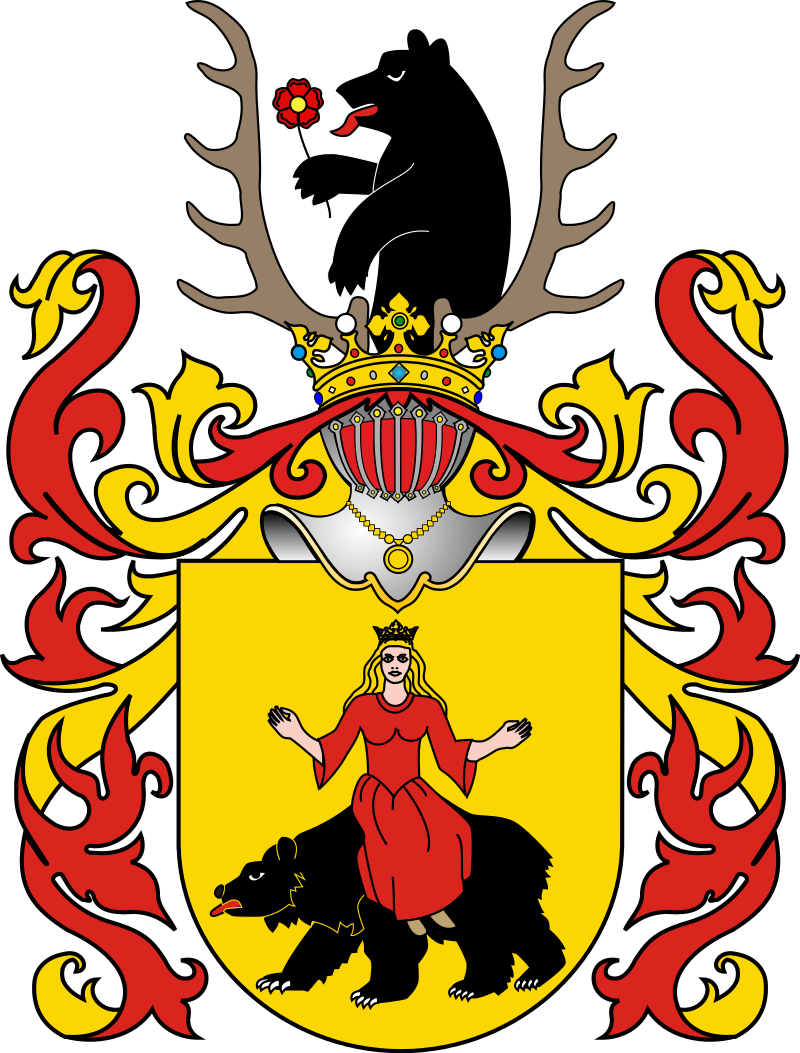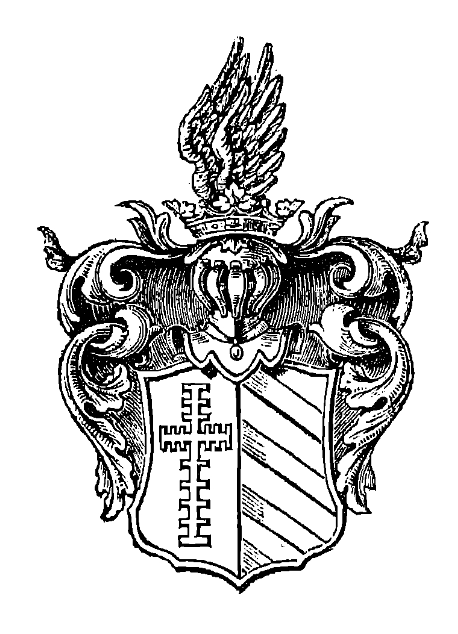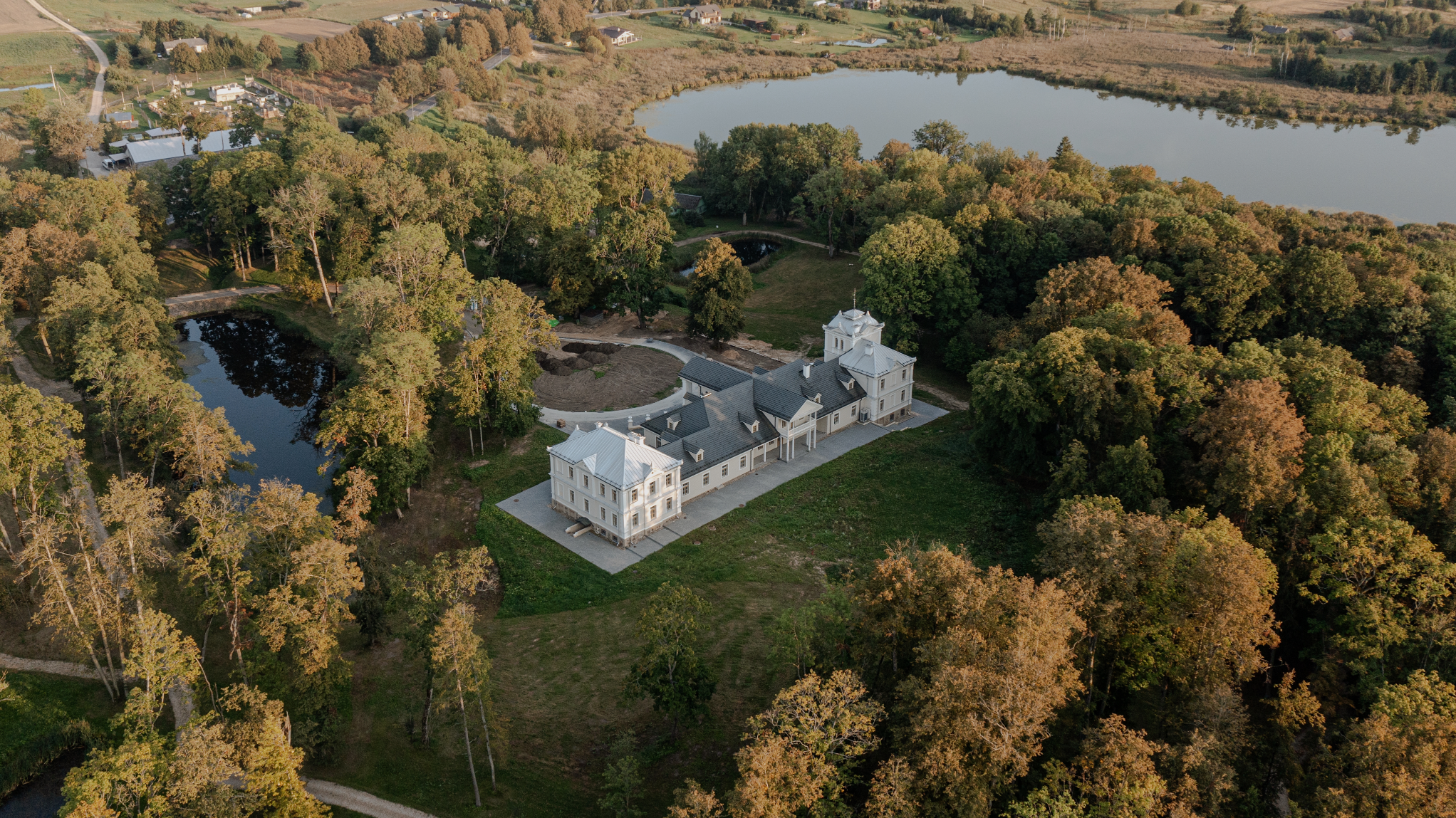Abromiškės Manor
Early history of the manor
The history of Abromiškės (Abromiszki) Manor is traditionally traced back to the late 16th century, more precisely to 1571, when Abraham Poniatowski built a palace here. However, surviving archival sources allow us to begin the story earlier, from a time when the manor was not yet known as Abromiškės (Abromiszki).
In the early 16th century, the land that would eventually become the sole property of Abraham Poniatowski belonged to several owners: Łukasz Chrzczonowicz, Piotrowicz, Juriewicz, Maciejowicz, Woytkiewicz, and Eysmontowicz. Between 1528 and 1533, Jan Janowicz and his wife Anna Hryniówna began purchasing these estates. These consisted of hayfields near Lake Landukas, the lake itself, settlements, and fields near the Troki road (2). Some of these estates, especially those formerly belonging to Eysmontowicz and Juriewicz, were referred to in documents as Strėvininkai (Strawienniki) (3), suggesting they had once been part of a larger manor.
Around 1533–1535, Jan Janowicz passed away, and soon after, his widow Anna married Abraham Poniatowski. Through a “perpetual renunciation” (Polish: prawo wieczyste/wieczyste zrzecznie) she transferred part of her property to him. From approximately 1537 onwards, the new husband of Anna Hryniowna, like his predecessor, began acquiring surrounding lands. Chrzczonowicz sold his part of Strėvininkai (Strawienniki) to Poniatowski for 46 kopas (currency units), and shortly after, Anna Adamówna sold her share of Strėvininkai (Strawienniki) for 30 kopas. A mid-18th-century list (4) of old manor property documents indicates that by 1560, Poniatowski had acquired the remaining part of Strėvininkai (Strawienniki) under his wife’s control, as well as property previously inherited by Jan Janowicz’s brother, Maciej Janowicz, thus becoming the full owner of these estates. It is likely that around this time, the lands under his control began to be called Abromiškės (Abromiszki).
Although no information has been found about the manor complex during Poniatowski’s tenure, it is known that the Abromiszki tavern was built on the Vilnius road coming from Kaunas. This tavern was established by a Jew named Hryszko Janaszkowicz under a privilege granted by King Sigismund II Augustus on 29 March 1552 (5). The rent paid to Poniatowski amounted to 5 Lithuanian kopas annually.
However, over time, Poniatowski faced a significant problem: he had no heir from his marriage to Hryniówna, and apparently no close relatives, complicating the issue of inheritance. Around 1569, perhaps compelled by circumstances or personal affinity, already of advanced age, the lord decided to adopt as his son (Polish: przybrać za syna) Erasm Dowgierd (6), the keeper of Perewelka and the land judge of Trakai (Troki), transferring to him the property he had accumulated over decades. Unfortunately, this gift proved too burdensome for his adopted son, who returned all property documents to Poniatowski, thereby, of course, leaving the latter in the same awkward position again.
Ultimately, Poniatowski had no choice but to sell the estate. On 1 August 1571, Mikołaj Bychowiec became the new owner of Abromiškės (Abromiszki), as documented in a parchment deed. The property sold included land inherited from his wife Hryniówna, as well as estates he had acquired himself, the aforementioned tavern on the Vilnius road, and nine lakes: Mindule, Arvis, Domblis, Sednis, Kundra, Duboklis (now Dubuklis), Eukudis, Wilkogolnis (likely present-day Vilkagalvis), Malozerelis and others (7).
Abromiškės in the 17th –18th centuries: the Bychówiec and Wołmiński families
The Bychówiec family owned the manor for several decades, up until the late 17th century.
Mikołaj Bychowiec and Gruzewska had a son, Dimitry, who served as a scibe in the Troki Land Court and later as a deputy judge. He married Anna of the Buchowiecki family (Polish: Anna z Buchowieckich) and inherited his father’s property upon his death. During Dimitry’s tenure, there were ongoing transactions involving land sales and purchases with the Bartaszewicz, Kiszka, Ogiński, Koklin, Strawinski and Januszewicz families. From the latter, the Bychówiec acquired estates called Szoltenie and Zerebientowicze. They also purchased the Urkiszki Sobolewski folwark (8) from Mikołaj Kiszka, castellan of Troki, for 9,000 Lithuanian gold coins.
While no detailed information about the manor complex in the early 17th century survives, early 20th-century press references mention an Evangelical Reformed church built on the estate in 1600 by the then owners. This church was later replaced by a Socinian church (Polish: zbór socyniański/ socyjański) with an associated school. According to Antoni Urbański, the house of prayer in Abromiškės (Abromiszki) operated until the late 17th century, after which it fell into ruin (9).
Though Urbański’s account was belated, it holds weight. In his will, D. Bychówiec bequeathed his estate to Helena of the Bychówiec family (his daughter or sister), who was married to Michał Wołmiński, judge of the Upyte Land Court (Polish: Helena z Bychowcow Michałowa Wołmińska) (10). Little is known about the Wołmiński family (sometimes called Wołmeński). Bearing the Rawicz coat of arms, the family appears in Grand Duchy of Lithuania records from the mid-16th century and was previously known by the name Nessuta (11). One of its patriarchs, Jan Wołmiński, a court official of Queen Bona, had a distinguished military career and was rewarded with land by the ruler. The family was closely allied with the Radziwiłłs, with their ancestral estate located in Sudervė (Suderwa) near Dubingiai (Dubinki). The inventory of the estate division, drawn up in 1611 at the initiative of Jan Wolmiński, the elder of Krėva, after his father's death, states that in Sudervė (Suderwa) stood the evangelical prayer house founded by the Wolmiński family, where the remains of their ancestors were interred (12). This suggests a possible link with Abromiškės (Abromiszki). In 1641, Michał Wołmiński and his wife Helena Bychowcowa sold the Suderwa manor to Michał Zenavicz and Apolonia Ogińska, possibly planning to settle at Abromiškės (Abromiszki).

The RAWICZ coat of arms of the Wołmiński / Wołmeński family
At the end of the 17th century, Helena of Bychówiec- Wołmińska, divided her property by will among her brother’s three grandsons—Maciej, Antoni (parish priest of Traby, now Belarus), and Francis Wołmiński, a Jesuit in Kaunas.
The estate at this time included the villages of Dowdzielany, Wolkowo, Pakalniszki, Sztykance, Gieybany, Soboliszek, Kokliniszki, and the folwark of Owsianiszek.
The eldest of the brothers, Maciej, bought out his siblings’ portions and became sole owner. Unfortunately, barely having done so, he passed away, and since he left no children, returning the estate to his brothers, who pursued clerical careers. In 1724, they sold the entire property for 40,000 Lithuanian gold coins to Marianna of the Eysmontowy family- Romerowa (Polish: Marianna z Eysmontow Romerowa) (14), widow of Jerzy Romer, senior military officer of Wilkomierz and mayor of Zasław.
This sale is significant, as it prompted the drawing up of the oldest known inventory of Abromiškės manor. In 1724, the manor complex was described as follows:
"The entrance gate from the Sabaliszki side, covered with boards, is dilapidated. Entering the courtyard to the left, there is a garden on the side and at the end of the manor house, surrounded by a dilapidated fence. The palace is large with two wings and chimneys, with vaults or cellars underneath <…>. Moving from the palace to the garden on the left, there is a gate covered with shingles, a wooden two-storey barn or storehouse, to the right of which is another palace, formerly a kitchen but now empty and completely collapsed, without stoves or windows, with only one room. To the right of this building is a barn with a granary, with three windows, next to a brewery by the pond. Additionally, there is a folwark building with a bread oven, two stables nearby, both dilapidated, barns and sheds behind them, two simple barns, on the right side going towards the granary two dilapidated barns, the second containing a cheese cellar still in reasonable condition <…>. Also noted are three collapsed cattle sheds and one cart shed.“(15)
Although brief, this description provides insight into the manor’s condition. The main residence was large but overall the buildings—especially farm structures—were old and in poor repair, likely constructed several decades earlier (possibly during the Bychówiec era). Thus, the manor resembled a 17th-century estate past its prime. Interestingly, the inventory mentions as many as 24 lakes associated with the manor, some shared with neighbours, including:
Onikszty, Punkon, Pankinaytis, Andrynelis, Agade, Grys, Nowinkis, Sianozeris, Tandulis, Dabaklis, Jagudelis, Tatarezeris, Wilkogalinis (by the road), Kupaksztelis, Bizdus, Kodrolis, Dumblis, Mizyklis, Warletis, Petoknis, Zelbis, Zapojas, Bierzdis and Alasis.
There were also four ponds, and a mill near the pond in Gejboni.
It is claimed in printed sources that in the middle of the 18th century, around 1740, the Abromiškės (Abromiszki) manor passed to the de Raes family when Anna Karpówna married into it. While the precise basis for this is unclear, archival documents show that the de Raes family actually acquired Abromiszki somewhat differently. In 1725, the new owner quickly sold the estate, including the Ausieniński folwark (often disputed in property claims), to Kazimierz de Raes and Feliciana of the Eysmontówy family- de Raesowa (polish: Feliciana z Eysmontow de Raesowa)—apparently her sister and her husband.
A new stage – the De Raes family
The appearance of the De Raes family marks a new chapter, as Abromiškės (Abromiszki) became their main suburban residence. The central part of the palace still standing today is associated with their tenure. First, however, it is worth exploring the family’s origins and their arrival in the Grand Duchy of Lithuania.

The coat of arms of the De Raes family
The origins of the De Raes family are somewhat unclear. Irma Randakevičienė, who has examined this topic in detail, suggests their roots lie in Habsburg Bohemia. The dynasty’s founder was Albrecht the Elder from the village of Kolowrat in the 14th century (16). The family name is linked with Gotfryd Kolowrat-de Raes. The first member to settle in the Polish-Lithuanian Commonwealth was Henrik Kolowrat-De Raes, who arrived from the Duchy of Lorraine in the mid-17th century, around 1642 (17) according to Niesiecki. Upon arrival, he acquired estates near Minsk, in Rykonty, and in the Troki Voivodeship. Literature suggests he was invited by Bogusław Radziwiłł as an experienced military commander to train his troops. This is plausible, as the Duchy of Lorraine had been part of the Holy Roman Empire since the 12th century and played a significant role during the Thirty Years’ War (1618–1648), aligning with French interests.
Settling here, De Raes participated in numerous military campaigns alongside Duke Radziwiłł against Swedes, Muscovites, Hungarians, Cossacks, and Tatars (19). For his valour and loyal service, he was granted nobility rights, the position of Vitebsk cup-bearer, and land holdings.
Henrik married twice. His first wife, surname Raczynska, her first name is not known, bore no children. His second wife was Marianna, daughter of Marcin Brzostowski, deputy master of the pantry from Rava, and Princess Katarzyna Mirska. They had ten children: three sons—Kazimierz, Jan, Stanisław—and seven daughters—Katarzyna, Teofila, Marianna, Teresa, Konstancja, Regina and Dominyka (20).
Kazimierz de Raes, like his father, served as Vitebsk cup-bearer and was elected deputy of the Supreme Tribunal of Lithuania in 1722. He married Feliciana Eysmontówna, daughter of the Orsha cupbearer, and had three sons: Józef, Antoni, and Tadeusz. Both Kazimierz and Feliciana were noted patrons of the Jesuit College in Słuck (21).
In 1763, Kazimierz and his brother Francis de Raes graduated from Vilnius University, defending their theses in mathematics (22).
2. LMAVB RS, f. 138, b. 1451.
3. Strėvininkų pavadinimas šiuo atveju pradeda figūruoti 1531 metais. Istorijoje daugiau yra žinomi nuo XVII a. Oginskių giminės valdyti Mūro Strėvininkai, nuo Abromiškių nutolę apie 20 km. Taip pat yra išlikęs ir kaimas Strėvininkų pavadinimu, esantis 17 km į Pietus nuo Abromiškių. Taip pat Strėvininkais kadaise vadintas ir Granapolio palivarkas.
4. LMAVB RS, f. 138, b. 1451.
5. LVIA, SA 112, l. 829v.
6. Erazmas Daugirdas Trakų žemės teisėjo pareigas ėjo 1565–1577 m. Prieš tai buvo Pervalko laikytojas (nuo 1563 m.). Jis buvo vedęs keturis kartus: 1-ą kartą Oną Palubinską (lenk. Anna Wasilewna Połubińska), Mikalojaus Zavišos (lenk. Mikołaj Zawisza) našlę, 2-ą – Aleksandrą Pacaitę (lenk. Aleksandra Mikołajówna Pacówna), 3-ią – Sofiją (lenk. Zofia Andrejewna N.), Ivano Basinos (lenk. Iwan Michajłowicz Basina) našlę, 4-ą – Apoloniją Drucka-Sokololinską (lenk. Apolonia Drucka-Sokołinska). Erazmo tėvas Bogdanas Daugirdas 1533-1538 m. taip pat ėjo Pervalko laikytojo pareigas. Pagal: Urzędnicy Wielkiego Księstwa Litewskiego, spisy, t. II: Województwo Trockie XIV-XVIII wiek, Warszawa: Wydawnictwo DiG, 2009, p. 177, 195.
7. 1571 m. rugpjūčio 1 d. pardavimo aktas buvo įrašytas Trakų miesto teismo knygose, o vėliau, 1575 m. vasario 11 d. Įrašytas ir Trakų žemės teismo knygose. Žr. LVIA SA 112, l. 828v–829.
8. SA 112, l. 837.
9 Tiesa, minima, kad tuo pačiu metu Bogdanas Oginskis „čia pastatė Šv. Dvasios vienuolynui Vilniuje pavaldžią unitų bažnyčią“, tad nereikėtų atmesti ir prielaidos. kad Abromiškės painiojami su kaimynystėje buvusiais Mūro Strėvininkais. Žr. Antoni Urbański, Kresowe siedziby polskie, które uległy zagładzie, in: Tygodnik illustrowany, Nr. 2, p. 45.
10. Dmitrijaus Bychovco ir Elenos Bychovcaitės giminystės ryšys iki galo nėra aiškus. Literatūroje ji nurodoma kaip Dmitrijaus sesuo, tačiau, pavyzdžiui, 1654 m. pakvitavime įvardijama kaip „dmitrijevna“, t. y. duktė. Žr. LMAVB RS, f. 318-25176, Upytės iždininko Mykolo Kazimiero Zgierščo Volminskio ir jo žmonos Elenos Dmitrovnos Bychovcovnos Volminskos pakvitavimas Reginai Zavackai Pavlovai Vilčakovskai dėl tam tikros pinigų sumos, 1654 m.
11.Niesiecki, Herbarz Polski, t. 9, p. 411–412.
12.LNMMA, f. 94, b. 843, Krėvos seniūno Jono Volminskio raštas, kuriuo paskirsto artimiesiems tėvo palikimą, 1611 m. Beje, iš šio dokumento sužinome ir apie kitas Volminskių turėtas valdas: Gaižuvą (lenk. Gajzowo), Vadaktus (lenk. Wadakty) ir Volmiškes (lenk. Walmiszki). Dalinantis tėvo turtą pirmasis dvaras atiteko Jurgiui Volminskiui, o antrasis – Jonui.
13. VUB RS, f. 4, b. 36934, 1641 m. Sudervės dvaro ir palivarko inventorius.
14. LVIA, SA 112, l. 825–826.
15. LVIA, SA 112, l. 968–971.
16. Irma Randakevičienė, „XIX a. Vilniaus ir Abromiškių bei Dembinos dvarų gyventojai Kolovratai – de Raesai ir jų giminystės ryšiai“, in: Voruta, interaktyvus, https://www.voruta.lt/xix-a-vilniaus-ir-abromiskiu-bei-dembinos-dvaru-gyventojai-kolovratai-de-raesai-ir-ju-giminystes-rysiai/, [žiūrėta 2023-07-02].
17. Niesiecki, Herbarz Polski, t. 8, p. 83.
18. LVIA f. 391, ap. 1, b. 993; f. 394, ap. 4, b. 2406.
19. Niesiecki, Herbarz Polski, t. 8, p. 84.
20. Kazimieras su Felicija susilaukė trijų sūnų: Juozapo, Antano ir Tado. Jonas ėjo Žečycos pilies teisėjo pareigas ir buvo vedęs Barborą Eismontaitę (lenk. Barbara Eysmontt), su kuria susilaukė dukters Felicijos, ištekėjusios už Stanislovo Valavičiaus (lenk. Stanisław Wołłowicz, m. 1737). Stanislovas tapo Gele seniūnu, buvo vedęs Bikovskytę (lenk. Bykowska), tačiau vaikų nesusilaukė. Kotryna ištekėjo už Naugarduko pilies teisėjo ir taurininko Stanislovo Korsako (lenk. Stanisław Korsak). Teofilė pirmą kartą ištekėjo už Naugarduko pataurininkio Jono Vainos (lenk. Jan Woyna), antrą kartą – už Smolensko kašteliono Kazimiero Niesiolovskio (lenk. Kazimierz Niesiolowski). Marijona pirmą kartą tapo Jono Žernickio (lenk. Jan Zernicki), antrąjį – Bakos-Masalskio žmona. Teresė ištekėjo už Stanislovo Klokockio (lenk. Stanisław Kłokocki), Dobryno medžioklio, Konstancija – už Breslaujos sargybinio Kosakovskio. Regina tapo Kostrovickio žmona. Dominyka įstojo į Vilniaus benediktinių vienuolyną.
21. Niesiecki, t. 8, p. 84. Beje, Kazimiero sesuo Teresė buvo ištekėjusi už Dobryno ....Stanislovo Klokockio. Šis greičiausiai giminiavosi su Slucko jėzuitų kolegijos fundatoriumi Jeronimu Klokockiu, kas paaiškintų didžiulį de Raesų dėmesį kolegijai.
22. Ina Kažuro, „Senojo Vilniaus universiteto tezės: pagrindiniai bruožai ir sklaidos ypatumai”, in: LMA Vrublevskių bibliotekos darbai, 2022, nr. 11, p. 74 [56-75].


